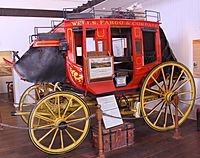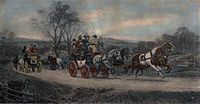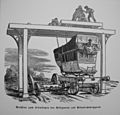Stagecoach facts for kids
A stagecoach was a special type of coach pulled by horses. It was used to carry passengers and goods across long distances. These coaches were some of the first organized public transport systems. They first appeared in Great Britain in the 1600s. Before trains became common in the 1800s, stagecoaches were the fastest way to travel far. They were used all over Europe and North America.
The coach would stop at special places called stages. At these stops, passengers could get food and drinks. The horses pulling the coach would also be swapped for fresh, rested ones. Changing horses regularly helped the coach travel much faster than other vehicles. Stagecoaches were often built to be light, which also helped them go quickly. Because of their speed, they were often used to carry mail and were sometimes called a mail coach.
Contents
How Stagecoaches Worked
Stagecoaches were designed for speed and efficiency. They followed set routes and schedules. This made them a reliable way to travel.
The "Stages" and Fresh Horses
The idea of "stages" was key to how these coaches worked. A stage was a stop along the route. At each stage, the tired horses were unhitched. Then, a new team of fresh horses was hitched up. This allowed the coach to keep moving without long delays. It meant the journey could be completed much faster. These stops also served as places for passengers to rest. They could eat and drink before continuing their journey.
Speed and Design
Stagecoaches were built to be lighter than many other wagons. This light design helped them move faster. Their speed was very important. It allowed them to deliver mail and people quickly. Some coaches, like the famous Concord stagecoach, had special leather strap suspensions. These straps helped make the ride a bit smoother on bumpy roads.
Life on a Stagecoach
Traveling by stagecoach was an adventure. It was also often quite challenging. Journeys could be long and uncomfortable.
Passenger Experience
Riding inside a stagecoach could be a tight squeeze. Passengers often sat very close together. The roads were not always smooth. This meant the ride could be very bumpy and dusty. Journeys could last for many hours or even days. Passengers would often have to stop overnight at inns along the route.
Challenges and Dangers
Travel by stagecoach had its difficulties. Bad weather could make roads muddy or snowy. This would slow down the coach. Sometimes, the coach might even get stuck. Passengers might have to get out and help push. While rare, there was also a risk of encountering robbers. Drivers and guards worked hard to keep passengers safe.
The End of the Stagecoach Era
Stagecoaches were very important for travel for many years. However, new inventions eventually replaced them.
The Rise of Railways
In the 1800s, a new form of transport appeared: the railway. Trains could travel much faster than stagecoaches. They could also carry many more passengers and goods. Trains were also more comfortable and reliable. As railways expanded, stagecoach routes slowly became less popular. Many stagecoach companies eventually went out of business.
A Lasting Legacy
Even though stagecoaches are no longer used for regular travel, they left a big mark. They helped connect towns and cities. They made it easier for people and mail to move around. Stagecoaches are still a popular symbol of the Old West in movies and stories. They remind us of a time when travel was a grand adventure.
Images for kids
-
A public notice advertising a new stage coach service in west Wales, 1831
-
Construction of a macadamized road in the United States (1823). These roads allowed stagecoaches to travel at much greater speeds.
-
Carriage driving, 1881. The owner's coachman watches Henri de Toulouse-Lautrec
-
The body of a diligence being transferred to a railroad car with a simple gantry crane, an example of early intermodal freight transport by the French Mail, 1844. The drawing is exhibited in Deutsches Museum Verkehrszentrum, Munich, Germany.
-
McLaughlin Stagecoach with birthday party, 1880s in Park County, Colorado.
-
Buffalo soldiers guard a Concord stagecoach, 1869
See also
 In Spanish: Diligencia (carruaje) para niños
In Spanish: Diligencia (carruaje) para niños















